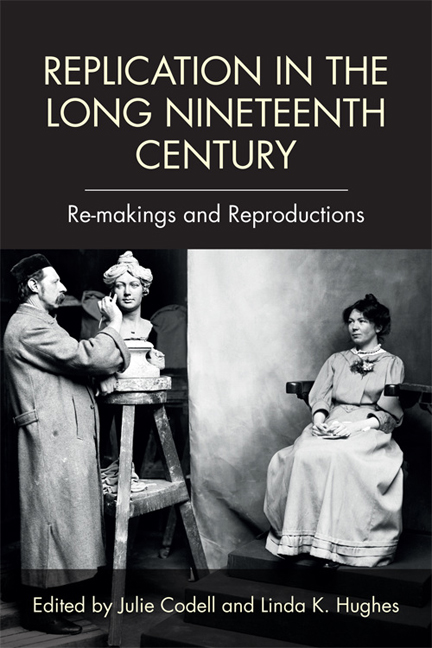Book contents
- Frontmatter
- Contents
- List of Illustrations
- Acknowledgments
- 1 Introduction: Replication in the Long Nineteenth Century – Re-makings and Reproductions
- I Replication and Networks
- II Replication and Technology
- III Replication and Authenticity
- 10 Literary Replication and the Making of a Scientific “Fact”: Richard Owen's Discovery of the Dinornis
- 11 Copying from Nature: Biological Replication and Fraudulent Imposture in Grant Allen's An African Millionaire
- 12 The Failure of Replication in Nineteenth-Century Literature: Why It All Just Comes Out Wrong
- IV Replication and Time
- Notes on Contributors
- Index
12 - The Failure of Replication in Nineteenth-Century Literature: Why It All Just Comes Out Wrong
from III - Replication and Authenticity
Published online by Cambridge University Press: 11 August 2018
- Frontmatter
- Contents
- List of Illustrations
- Acknowledgments
- 1 Introduction: Replication in the Long Nineteenth Century – Re-makings and Reproductions
- I Replication and Networks
- II Replication and Technology
- III Replication and Authenticity
- 10 Literary Replication and the Making of a Scientific “Fact”: Richard Owen's Discovery of the Dinornis
- 11 Copying from Nature: Biological Replication and Fraudulent Imposture in Grant Allen's An African Millionaire
- 12 The Failure of Replication in Nineteenth-Century Literature: Why It All Just Comes Out Wrong
- IV Replication and Time
- Notes on Contributors
- Index
Summary
“Hegel remarks somewhere that all great world-historic facts and personages appear, so to speak, twice. He forgot to add: the first time as tragedy, the second time as farce.”
Marx, The Eighteenth Brumaire of Louis Napoleon (Marx 1)“What IS the use of repeating all that stuff … if you don't explain it as you go on?”
The Mock Turtle, Alice's Adventures in Wonderland (Carroll 140)In nineteenth-century British fiction, replication, in the sense of both repetition and duplication, seems to be a common feature, especially of the fiction we now classify as canonical. In this essay I will mainly be using the term “replication” interchangeably with “repetition” but will argue that both differ from the semantically close term “representation” for the obvious reason that a “representation” need not resemble what it represents. It merely has to signify what it represents, and the form that signifier takes need not resemble what it represents any more closely than Ferdinand de Saussure's drawing of a tree in his Course in General Linguistics “resembles” the English word “tree.” Iconic representation, in other words, is by no means the only form of representation, as the American pragmatist philosopher C. S. Peirce noted some time ago (Peirce).
A structural feature of much novelistic plotting but particularly prominent in the Bildungsroman, repetition, as Peter Brooks argues, is central to establishing metaphorical meaning effects generated at the level of plot (Brooks 503–5). At the level of character in nineteenthcentury fiction, doubled characters are often used to insinuate a close thematic linkage between seemingly opposite character traits, such as, for instance, respectability and monstrosity.
- Type
- Chapter
- Information
- Replication in the Long Nineteenth CenturyRe-makings and Reproductions, pp. 213 - 228Publisher: Edinburgh University PressPrint publication year: 2017



